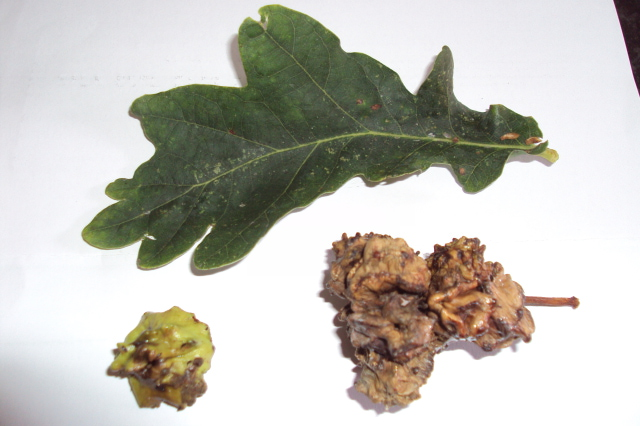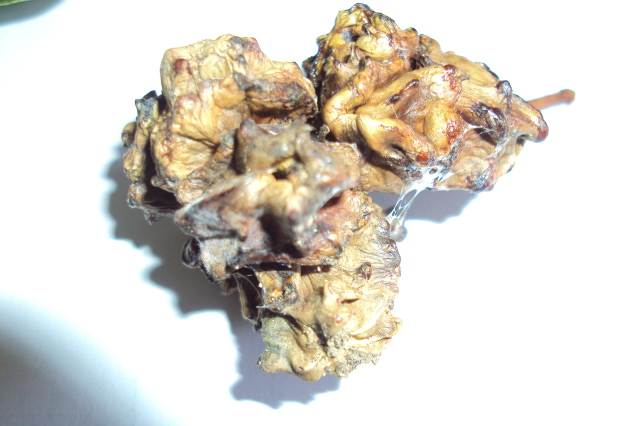Question
 Oak Tree growth
Oak Tree growth  Oak Tree growth 2
Oak Tree growth 2
Could you please identify and explain the growths which are falling from the Oak Tree at the bottom of our garden? The growths are in the same position as you would expect to see acorns (which the tree has produced in the past). They start off green and seem to be sticky then harden off & turn brown. Sometimes they are single & sometimes a group bunched together as in the photo. As you can see from the photos attached, the leaves do not seem to be affected but the lumpy growths are prolific.
Is the tree diseased? Does any action need to be taken and if so what?
Thank you
Kind regards
Jan Adams
AnswerThese are oak galls more than likely horned oak gall. This is an insect. There are a variety of gall-forming species of small wasps that commonly infest oak, Quercus spp. Most leaf galls on oak cause little or no harm to the health of a tree. However, twig or branch galls may cause injury or even death to a heavily infested tree. Two common species of twig gall-producing insects are the horned oak gall wasp, Callirhytis cornigera (Osten Sacken), and the gouty oak gall wasp, C. quercuspunctata (Bassett). These species are in the insect family Cynipidae. Both the horned oak gall wasp and the gouty oak gall wasp are known to occur from southern Canada to Georgia. Each of these galls may be diagnosed by their unique characteristic size, shape, and color.
Galls are abnormal plant growth or swellings comprised of plant tissue. Galls are usually found on foliage or twigs. These unusual deformities are caused by plant growth-regulating chemicals or stimuli produced by an insect or other arthropod pest species. The chemicals produced by these causal organisms interfere with normal plant cell growth.
The horned oak gall wasp, C. cornigera, attacks the twigs of pin, scrub, black, blackjack, and water oaks. The gouty oak gall wasp, C. quercuspunctata, develops in the twigs of pin, scarlet, red, and black oaks. Both of these woody twigs galls on oak look similar, but the horned oak gall has small horns that protrude from around the circumference of the gall.
The life cycles of the various gall-forming wasps are highly variable. Two or more years are required for gall wasps that develop in woody twig galls to reach maturity. Gall-forming wasps usually overwinter as adults in protected places away from the host tree. As the buds break in the spring and the leaves begin to expand, these small wasps start to lay their eggs in expanding plant tissue. During the egg-laying process or early larval-feeding period, specialized body glands secrete growth-regulating chemicals that interact with certain plant chemicals to produce these abnormal growths. After a brief period of cell growth, gall development stops completely. The insect is confined within 搃ts house?and feeds only on gall tissue during the remainder of its development. Once these galls are formed, they do not continue to use nutrients from the host plant.
In general, most leaf galls on oak do not affect the health of the host tree. A few can cause leaves to drop prematurely, or distort them so that photosynthesis (the plant抯 food-making process) is interrupted. Galls generally are aesthetically objectionable to homeowners who find them unattractive and fear that galls will cause damage to the health of their oak trees.
Chemical control is seldom suggested for management of leaf galls on oak. Cultural methods of control may be effective in reducing the impact of these insects. Some fallen leaves may harbor various life stages of gall-producing pests. Therefore, it may be useful to collect and destroy all infested leaves. Some of these pests overwinter in twigs and branches of oak. Where such woody galls are detected, prune and destroy the infested plant material when the galls are small and have just started to develop.
Once a gall begins to develop, it is almost impossible to stop or reverse its development. Unless registered insecticides can be applied when gall wasps are flying, they offer little or no effective measure of control. Lack of serious plant damage from leaf galls and the difficulty in proper timing of insecticide applications pose a strong argument against the use of insecticides to reduce galls on oak.
In short, the galls will not kill the tree and usually natural controls will keep the population from repeating next year.
Generally, insecticidal control is not satisfactory because the wasps are physically protected within the galls. Correctly timing applications to provide effective preventive control is difficult. Where practical, pruning of infested twigs may help to reduce the problem on lightly-infested trees. However, pruning is impractical if large trees are heavily infested.
I would not be too concerned with the galls they really do little to harm the tree. Here is web site that gives more information on oak galls. http://www.ento.psu.edu/extension/factsheets/gallsOnOak.htm







